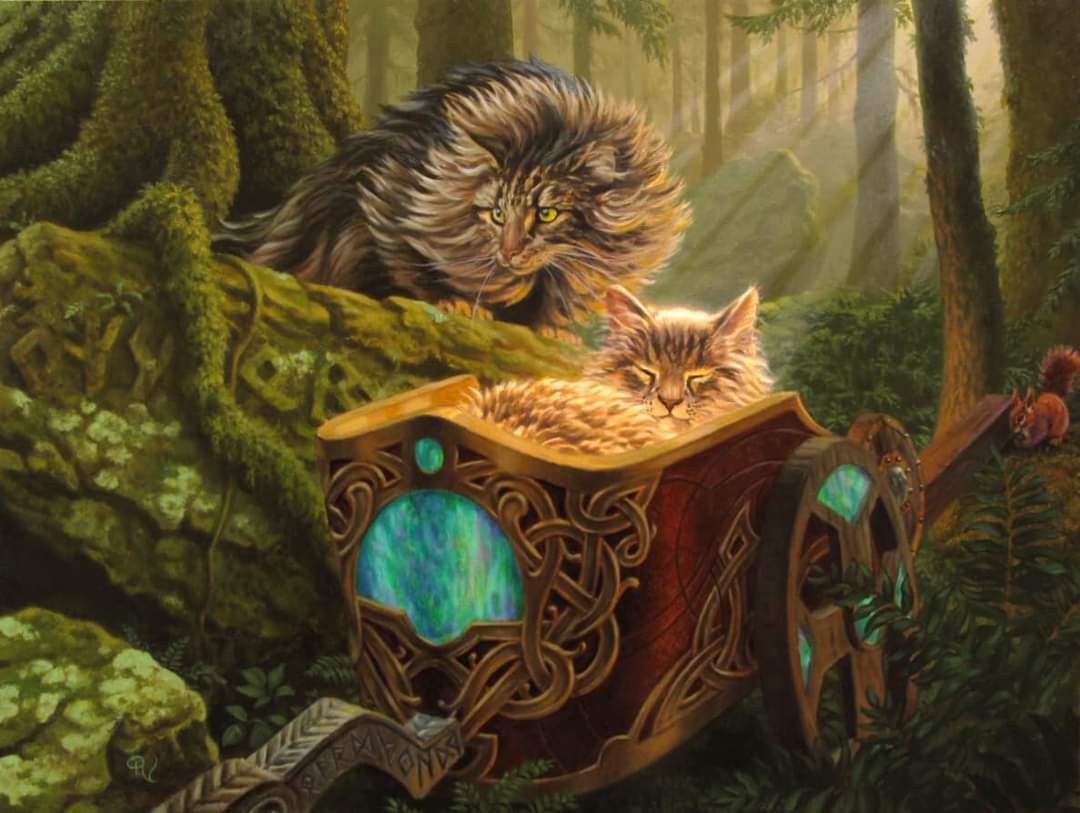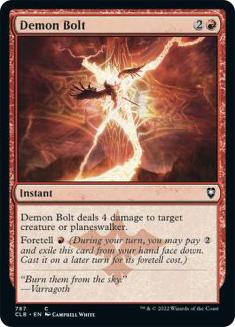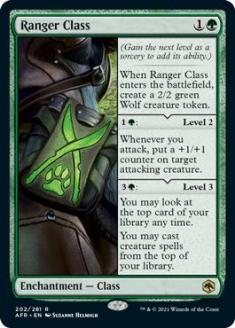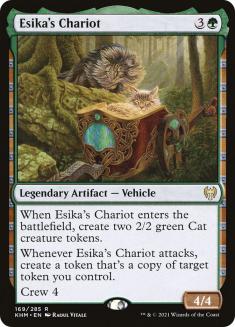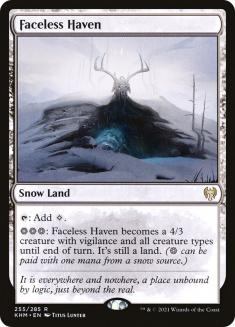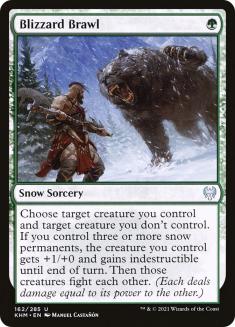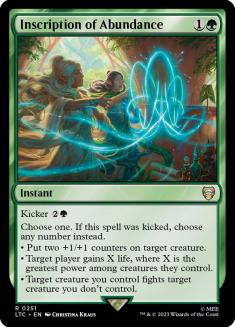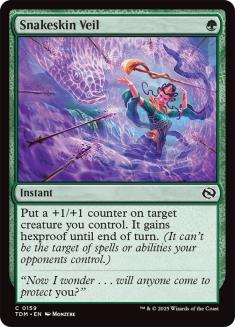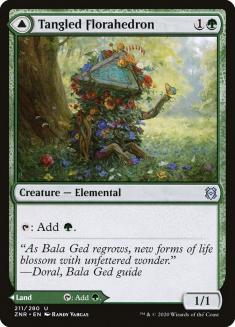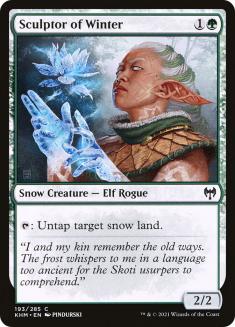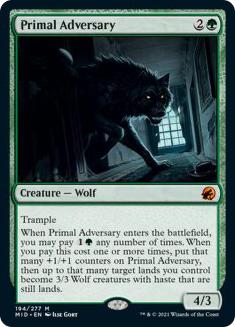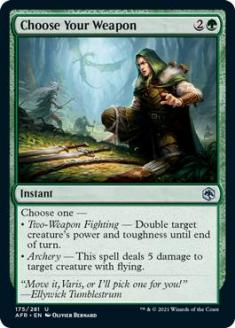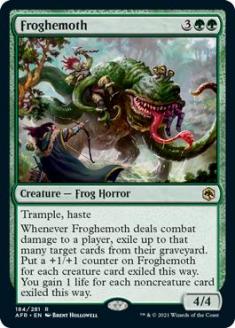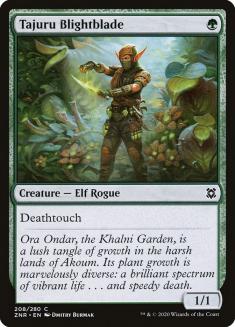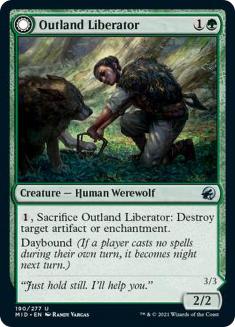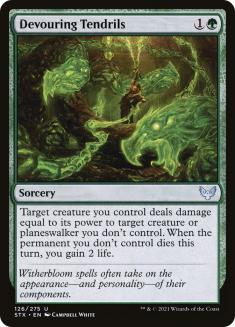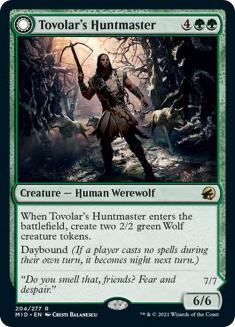Going into Magic World Championship XXVII, Innistrad: Midnight Hunt Standard had two clear best decks in my mind: Mono-Green❄ Aggro and Izzet Epiphany. Other decks were playable, but you couldn’t be 55% against one of those without being 35% versus the other, and this was a gamble that required a very high degree of confidence that the metagame would break in the right way for you. Very early on in the testing process I established that I would very likely be playing one of these two decks.
In my mind, Izzet Epiphany was the slightly better deck, but I also thought it was going to be the most-targeted. There was the expectation that it would be the most-played deck (it was putting up the best numbers), and players at a high level usually like this kind of deck more than they like something like Mono-Green Aggro❄. This would result in people tuning their decks to beat Izzet Epiphany, rather than Mono-Green. Mono-Green was a slightly less powerful deck, but I expected it to dodge a lot of the hate, because I expected everyone to believe that Izzet Epiphany was going to be the most played deck. Basically, if someone had a choice between playing Negate or Demon Bolt in their deck, I expected them to go with Negate.
Was that enough to tip the scales towards Mono-Green Aggro❄? I believed so, which is why I chose the deck that I thought was slightly (but only slightly) worse in abstract.
In practice, this was not what happened. I believe we underestimated the impact of the SCG Tour Online Championship Qualifier that happened right before the deck submission deadline, which Mono-Green ended up dominating (including a Mono-Green mirror win by Simon Nielsen in the finals).
I thought players would not pay too much attention to it because it was only one data point among many, and Izzet Epiphany still had the best win percentage overall if you counted all the results from the previous days, and also because that result was really close to the decklist submission, so it seemed reasonable that a lot of players would just not have the time or the inclination to adapt to it (we had already basically locked into Mono-Green at that point, for example). It turns out that people had both the time and the inclination, or were happy to target Mono-Green Aggro❄ from the start.
The reality was that players at the tournament adjusted their builds to beat Mono-Green Aggro❄, and not the other way around; 25% of the field, for example, cut all counterspells from their Epiphany deck, which I think made them dogs in the mirror, in exchange for a slightly better Mono-Green matchup, and the Mono-White Aggro decks were playing two Portable Holes and three Fateful Absences in the maindeck, which were cards that we felt we could not afford to play in our builds of Mono-White. As a result, Mono-Green Aggro❄ went from “slightly worse but a good metagame choice” to “slightly worse and a bad metagame choice,” which resulted in a disastrous performance by all three pilots (myself, Sam Pardee, and Seth Manfield).
I do think, however, that Mono-Green Aggro❄ is a much better deck than its performance at Magic World Championship XXVII would lead you to believe, and I still think it’s one of the best two decks in the format. In fact, I believe the same I believed before — that Izzet Epiphany is the slightly better deck, but that Mono-Green Aggro❄ is a close second and can become the best deck if you expect the right metagame for it.
Here’s the deck I played:
Creatures (19)
- 2 Tangled Florahedron
- 4 Kazandu Mammoth
- 4 Old-Growth Troll
- 4 Sculptor of Winter
- 4 Werewolf Pack Leader
- 1 Primal Adversary
Planeswalkers (2)
Lands (23)
Spells (16)

Mono-Green Aggro❄ is a very powerful deck because it’s resilient and attacks from many angles. You have strong creatures, but you also have Esika’s Chariot, planeswalkers, creature-lands, Ranger Class, and Old-Growth Troll, so you’re capable of grinding over even the best control decks. Between modal DFCs, Ranger Class, and creature-land activations, you rarely flood out as well. This makes the deck very well-rounded and no matchup is truly atrocious; in fact, almost every matchup with Mono-Green Aggro❄ is within the 45%-60% range.
Then, you have what is probably the most efficient removal spell in the format — Blizzard Brawl. Blizzard Brawl is incredible and it’s the reason to play Mono-Green as opposed to splashing another color; getting to kill their creature and attack without fear for only one mana is a steal, and having access to this card makes you favored in almost every creature matchup. Then, to round out the deck, you have some powerful, game-swinging instant-speed tricks.
The deck has many positives, but the negative is that it can be clunky. There’s simply no good one-drop to play in this deck, so if you’re on the draw, it can be quite hard to catch up if you fall behind. This is why Blizzard Brawl is so important; it lets you double-spell later in the game to reach parity again.
A lot of the slots in the deck are locked up. You’re not going to play fewer than four Werewolf Pack Leaders or Esika’s Chariots because these cards are just way too strong. Instead, I will focus on the key differences between our build and other builds.
The first difference is the amount of lands. We have 29. Some people have 29 as well, but a very common number is also 27, which I think is just way too few, especially since people tend to play more Lair of the Hydras than we do.
Lair of the Hydra isn’t a bad card, but it’s also not very good. You very rarely activate it (there are better uses for your mana most of the time), and it can be quite disruptive if you draw it later. Instead of playing Lair, we opted to play Tangled Florahedron, which facilitated Turn 3 Chariots. As a land, Florahedron is only worse than Lair of the Hydra exactly on Turn 2, but it can turn some bad hands into good ones. For example, I had a hand that consisted of five Forests, Tangled Florahedron and Esika’s Chariot on the play. If that Florahedron is a Lair of the Hydra, the hand goes from being good to being a mulligan.
The second difference is Sculptor of Winter over Lotus Cobra. Honestly, both have pros and cons; ultimately we decided Sculptor was better.
Pros:
- It’s a 2/2 instead of a 2/1, which can be quite relevant in a world of Spikefield Hazards.
- It’s a snow permanent. This can be very relevant when you play a Turn 1 modal DFC and then you want to fight on Turn 3 with Blizzard Brawl.
- It doesn’t require a land to add mana; two lands and a Sculptor will cast a three-drop, while two lands and a Cobra will not.
- It can add mana to animate Faceless Haven.
- It adds more than one mana with Old-Growth Troll (if it dies, you can put it on a land and untap the land).
- It’s adding mana at instant speed, which is quite relevant for Inscription of Abundance in particular, and we had three of that card.
Cons:
- It taps to add mana, which meant it couldn’t attack or crew Esika’s Chariot. A Turn 2 Cobra into Turn 3 Chariot can just attack for two, whereas the Sculptor is spent for the turn. If this goes on for two or three turns, the damage can really add up.
- It can’t add mana the turn it enters the battlefield, which means it’s clunkier in multiples, and especially much clunkier versus bounce effects. This is actually the biggest upside of Cobra over Sculptor, especially given the amount of bounce in the format. Imagine a hand of Sculptor of Winter, Werewolf Pack Leader and Ranger Class. Normally, you’ll want to cast the Sculptor first and then both the other two-drops on Turn 3. If they bounce your Sculptor of Winter with Fading Hope, however, your Turn 3 gets used up casting one of your two-drops. Now, imagine you have Lotus Cobra instead – if they bounce your Cobra, you simply cast Cobra + a two-drop on Turn 3 and you’ve sort of caught up.
In the end, I think Sculptor has more pros than cons, which is why we went with it, but I think we should have played at least one Lotus Cobra, because drawing two Sculptors is kinda bad, and drawing Sculptor + Cobra can be good. In my current version, I’m trying out two Cobras, but I think the right number is between one and two.
I like four slots for these spells, but you can honestly split them however you feel like. We opted to have three Inscriptions because we felt it was sort of good against everybody, whereas Snakeskin Veil was much better versus Izzet, but I regret that and should have played two of each. If you do play two of each, you’re going to max them both after sideboard anyway, so the sideboarding strategies shouldn’t be affected.
Basically, we wanted a five-drop, but we didn’t want to play too many five-drops, so we settled on the next-best thing. Trample was also very important versus the black decks, though no one ended up playing them.
Matchups
VS Izzet Epiphany
Honestly, I think this matchup is just even. It’s very play-draw-dependent (as are most matchups in this format and especially with Mono-Green Aggro❄) and it’s hard for either player to break serve. I think you’re a small favorite Game 1, especially with closed decklists, because there’s more that can go wrong for them than for you (sometimes their deck just doesn’t do anything).
Out:
In:
After sideboarding, I think things get a bit worse for you, because Smoldering Egg is just way too good. You can’t afford to have Blizzard Brawls (max one), so you’re simply going to lose to this card some of the time that it’s cast early and there’s not much you can do about it. It’s because of this that we added one copy of Choose Your Weapon — we wanted another Egg answer that was not totally dead if they didn’t have it.
Overall, considering Game 1 and sideboard, I would say this match is basically even.
I believe Grixis Epiphany is mostly a worse version of Izzet Epiphany, so we shouldn’t see it too much, but the sideboarding is not very different except that Froghemoth is a bit better there due to exiling cards for their Lier, Disciple of the Drowned. They also had more creatures (Mind Flayers too) so I liked keeping in one Blizzard Brawl.
VS Izzet Dragons
I think Izzet Dragons is also a worse version of Izzet Epiphany for the most part, but it did win the tournament, so that one I would expect to face. They can kill you faster than Epiphany decks, but your removal spells are also live in Game 1, and Wrenn and Seven is a lot better versus them because the token actually does a good job of blocking their Goldspan Dragons. I think this is a slightly better than even matchup, but not by a ton.
Out:
In:
VS Mono-White Aggro❄
This is a contentious matchup, but I think you’re a very small favorite or a very small dog depending on their build — against most conventional builds, you should be a small favorite. As always, winning the die roll is the most important thing in this matchup by a lot; I think the die-roll winner is over 75% to win Game 1. Cards like Reidane, God of the Worthy are game-breaking on the play and do almost nothing on the draw, for example. Overall, I would say they are small favorites in Game 1 because their deck is much cheaper than yours and they can go under you very effectively if you don’t draw Blizzard Brawl.
Out:
In:
After sideboarding I think things improve slightly for you. They get to add some good cards as well (Skyclave Apparition, Brutal Cathar, more removal), but you add more removal of your own and some cheaper cards, and that’s simply more important because being overrun is the main way you lose the game anyway. On an individual basis your creatures are mostly stronger, so try to keep the battlefield even and you’re going to win.
Wrenn and Seven is not bad, but it’s usually way too slow, and they often have Reidane and Elite Spellbinder to mess with it, so I prefer just cutting it altogether. It’s much better on the play though (especially because some players will cut Reidane if they’re on the draw), so you could consider having it there (you certainly should not have it on the draw).
VS Mono-Green Aggro❄
The mirror is all about, you guessed it, being on the play and drawing Blizzard Brawl. It can be a somewhat tricky matchup to play, but the reality is that most of the time you just have to hope they don’t have it (“it” usually being either Blizzard Brawl or Inscription of Abundance). This is the best matchup for Wrenn and Seven, because they usually can’t stop you from copying the token with Esika’s Chariot and then that just snowballs the game out of control.
Out (on the play):
In (on the play):
Out (on the draw):
In (on the draw):
Sideboarding for this matchup is kinda tricky, because a lot of the cards are “okay but not great” but they’re okay in different ways. Because of this, this is the matchup where I feel least confident in the sideboard guide and I can see basically any approach being correct. Ranger Class is usually the card people take out the most, but even that isn’t truly bad since it can turn any creature into a threat and on rare occasions it can win the super-long-game, so I like having at least one in my deck.
Here are the premises we’re operating with:
- Tajuru Blightblade is just okay on the play but necessary on the draw. Having the ability to just cast something on Turn 1 that scales well later into the game when you’re being defensive is super-important. That said, it’s possible that one or even both should still be in your deck if you’re on the play.
- Outland Liberator is similarly just okay. Sometimes you get a Chariot and it’s good; sometimes you get a Chariot and it’s not actually that great. We played a lot of mirrors to try to figure out if it’s better than Ranger Class and the honest answer is that I don’t know.
- Wrenn and Seven is very good if you’re on the play, but much weaker if you’re on the draw, so we only have the third one if we’re on the play.
VS Black Control Decks
These are supposed to be your bad matchups, and they are indeed not favorable, but I’ve also found them much better than what was reported. People keep saying Mono-Black “crushed Chariot decks” and I found that to be greatly exaggerated, because the Mono-Green deck is just too resilient and attacks from too many angles (sometimes they kill all your creatures and just lose to Ranger Class, for example).
Out:
In:
Froghemoth shines in this matchup, both because it can kill them after a sweeper but also because it can clear their graveyard (so they don’t have anything to return with Blood on the Snow) and because having trample means it can attack through their many chump blockers (trample is the single most important ability against these Mono-Black decks).
All the spells are just okay versus them. Snakeskin Veil looks like it would be great, but the reality is that they don’t even have that much targeted removal in their decks, so I don’t like it. Most people nowadays play a more creature-heavy version (including things like Sedgemoor Witch), so I like keeping in two Blizzard Brawls, but this is something you have to figure out depending on what you see in Game 1; against some versions of the deck that card is horrible and then you’re much better off with Snakeskin Veil.
I would make very few changes to my deck, but here’s the updated Mono-Green Aggro❄ version I’d play today if I were to play the deck:
Creatures (19)
- 2 Lotus Cobra
- 2 Tangled Florahedron
- 4 Kazandu Mammoth
- 4 Old-Growth Troll
- 2 Sculptor of Winter
- 4 Werewolf Pack Leader
- 1 Primal Adversary
Planeswalkers (2)
Lands (23)
Spells (16)

All in all, I think Mono-Green Aggro❄ is still a powerful deck, and still the second-best deck in the format to me. A lot of the matches against the most popular decks are even-ish, but no matchup is truly very bad, and a lot of the off-meta decks will be very good matchups, especially if they’re tweaked to beat Izzet Epiphany (things like Azorius Flyers, for example, are excellent matchups for you), which means it can become the best deck in the right metagame.
Right now, it feels like Mono-White decks are more popular than Mono-Green, but I think Mono-Green is better, so if you’re interested in the deck you should not get discouraged by its bad showing at Magic World Championship XXVII. It really is much stronger than it looked there.

